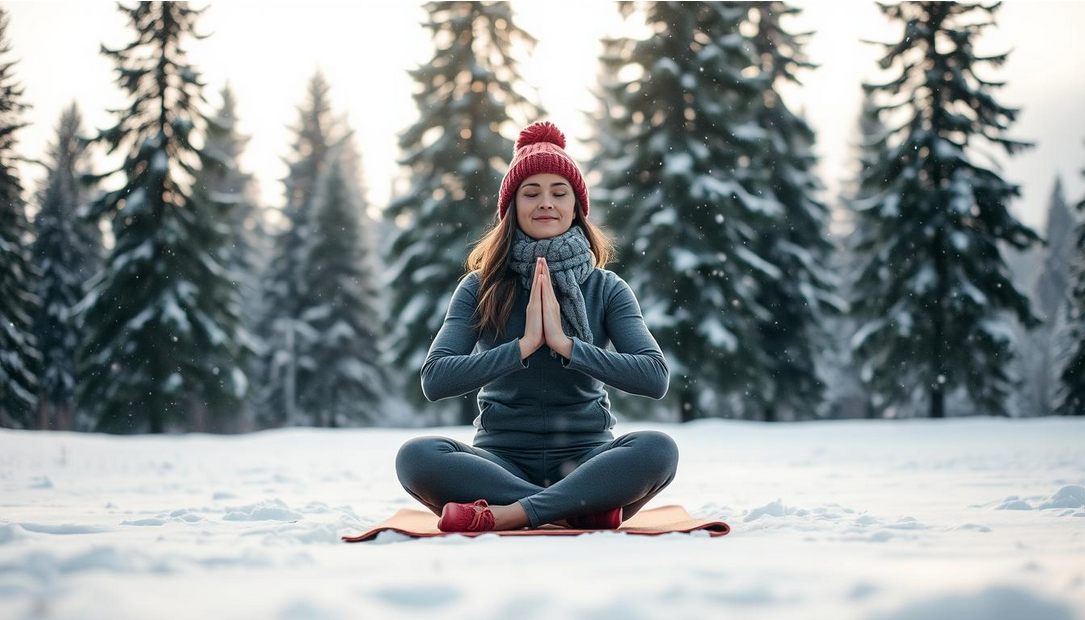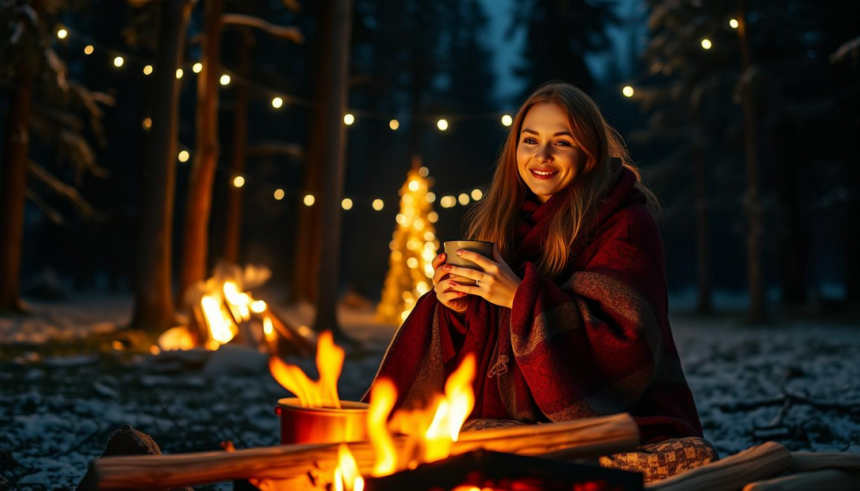From Bonfires to Lanterns: Winter Solstice Traditions Reimagined
As winter’s chill deepens and days shorten, the winter solstice celebration remains a global phenomenon. This tradition, tied to the seasons’ cycles, has grown from bonfires and light rituals to a rich mix of cultural events and new customs. From the warm glow of old bonfires to the soft light of lanterns, the solstice shows our eternal quest for meaning and connection in the darkest times.
- Understanding the Winter Solstice: Ancient Origins and Modern Significance
- The Scientific Explanation of Winter Solstice
- Historical Importance Across Civilizations
- Modern-Day Relevance
- The Evolution of Fire Rituals in Solstice Celebrations
- From Bonfires to Lanterns: Winter Solstice Traditions Reimagined
- Sacred Sites and Their Role in Winter Solstice Ceremonies
- Global Perspectives: Cultural Winter Solstice Traditions
- Modern Interpretations of Ancient Solstice Rituals
- Creating Community Through Winter Solstice Events
- Eco-Friendly Approaches to Solstice Celebrations
- The Symbolism of Light in Winter Solstice Traditions
- Incorporating Technology in Modern Solstice Celebrations
- Seasonal Foods and Feasts in Winter Solstice Traditions
- Conclusion
- FAQ
- What is the significance of the winter solstice?
- How have winter solstice traditions evolved over time?
- What are some common winter solstice traditions around the world?
- How can I incorporate sustainable practices into my winter solstice celebrations?
- What is the significance of light symbolism in winter solstice traditions?
- How can I create a meaningful winter solstice experience for my family or community?

Key Takeaways
- The winter solstice has been celebrated for centuries across diverse cultures and civilizations.
- Ancient fire rituals have evolved into modern lantern festivals, showcasing the adaptability of these traditions.
- Solstice celebrations often carry deep symbolic meaning related to light, renewal, and the cycle of the seasons.
- Sustainable and community-focused approaches to solstice events are gaining popularity.
- Embracing the cultural diversity and personal interpretations of winter solstice traditions is key to their continued relevance.
Understanding the Winter Solstice: Ancient Origins and Modern Significance
The winter solstice, known as the longest night of the year, is key in many traditions. It marks the sun’s lowest point in the sky. This event is important both scientifically and culturally.
The Scientific Explanation of Winter Solstice
The winter solstice happens when the Earth’s North Pole is farthest from the sun. This results in the shortest day and longest night. It’s caused by the Earth’s tilt and orbit around the sun, a wonder to scientists for ages.
Historical Importance Across Civilizations
Cultures worldwide have celebrated the winter solstice for centuries. Each has its own rituals, from the ancient Egyptians to Native Americans. It’s a time for reflection, renewal, and celebrating the seasons’ cycle.
Modern-Day Relevance
Even with today’s technology, the winter solstice remains important. People come together to mark the longest night with traditions. They light candles, hold lantern festivals, and celebrate the sun’s return and the new year.

“The winter solstice is the time of year when the shortest day and the longest night occur. It is a time of introspection, a time to reflect on the past and prepare for the future.”
The Evolution of Fire Rituals in Solstice Celebrations
The winter solstice has long been a time for bonfire winter solstice rituals. These are rooted in pagan rituals and ancient customs from centuries ago. Fire has been key in marking this important seasonal change, from Northern Europe’s yule traditions to indigenous cultures’ solstice celebrations.
These fire rituals started because of light and warmth’s symbolic meaning in the dark. Bonfires were lit to symbolize the sun’s rebirth and to fight off darkness. This held deep spiritual value for many ancient cultures.
- In Celtic traditions, the Yule log was burned to honor the solstice and usher in the return of the sun.
- Indigenous cultures in the Americas often incorporated ceremonial fires and torchlight processions into their winter solstice celebrations.
- The ancient Romans celebrated Saturnalia with bonfires and feasting, marking the end of the agricultural year.
These bonfire winter solstice traditions have changed over time. Some communities now use lanterns and other sustainable light sources. Yet, fire’s symbolism of renewal, hope, and the seasons’ cycle remains a core part of today’s solstice celebrations.
“The winter solstice is a time to reflect on the past and look toward the future, and the use of fire in our celebrations is a powerful way to honor that transition.”
Today, the pagan rituals and ancient customs of the winter solstice continue to evolve. They adapt to our modern society’s needs and values. Yet, they keep the timeless traditions that connect us to nature and our shared human experience.

From Bonfires to Lanterns: Winter Solstice Traditions Reimagined
As the winter solstice nears, we see a change from big bonfires to cozy lantern festivals. This change shows our wish to celebrate in a way that’s good for the planet. It keeps the spirit of old traditions alive.
Traditional Bonfire Practices
For ages, people lit big bonfires on the winter solstice. These fires were a beacon of hope in the dark. Communities came together, sharing stories and warmth as they welcomed the sun’s return.
The Rise of Lantern Festivals
Lately, we’ve moved to lantern festivals instead of big bonfires. These festivals have the soft light of handmade lanterns. People join in winter solstice lantern walk ideas, carrying their lanterns to celebrate together.
Sustainable Celebration Methods
- Switching to lanterns shows our care for the planet. Lanterns can be reused or recycled, cutting down on waste.
- Many events now use LED or battery lanterns to reduce carbon emissions. This makes lantern festivals solstice events greener.
- By choosing eco-friendly ways, we keep the solstice traditions alive for future generations.

The lantern festivals solstice now symbolize hope and community. They remind us of the light’s power to guide us through hard times.
Sacred Sites and Their Role in Winter Solstice Ceremonies
As the winter solstice nears, ancient traditions and cultural heritage shine at sacred sites worldwide. These places are key for stargazing and communal celebrations. They honor the changing of the seasons.
One famous site is Stonehenge in England. It aligns with the sun on the solstice, showing light and shadow on the stones. Rituals here connect today’s people with their ancestors.
- Other sites include the Chichen Itza pyramids in Mexico and the Sólstafir rock in Iceland. The sun’s shadow forms a serpent at Chichen Itza, and it sets between pillars at Sólstafir.
- In North America, indigenous communities gather at Pueblo Bonito in New Mexico. The solstice sun lights up specific parts of the architecture, guiding their celebrations.
These sites are like beacons, attracting people to see the link between the sky and culture. As the winter solstice comes, these places buzz with traditions passed down through generations. They remind us of our bond with nature.

“The winter solstice is a time to reflect on the past, embrace the present, and look forward to the future – all while honoring the timeless rhythms of the earth and sky.”
Global Perspectives: Cultural Winter Solstice Traditions
The winter solstice is celebrated in many ways around the world. It’s a time of deep spirituality and community. From ancient Saturnalia in Europe to indigenous solstice ceremonies in the Americas, it’s a period of reverence and togetherness.
European Customs
In Europe, the winter solstice has been celebrated for ages. It’s tied to ancient pagan rituals. The Roman Saturnalia was a big deal, filled with feasting, gifts, and even slaves getting a break.
This tradition grew into our modern Christmas. We see it in the Yule log, carols, and decorated trees.
Asian Celebrations
In Asia, the winter solstice brings its own set of traditions. China’s Dongzhi festival welcomes longer days and the victory of yang over yin. Families share dumplings and sweet rice balls, showing unity and the seasons’ cycle.
In Japan, Toji lights candles and brings families together for a quiet, warm meal. It’s a time for reflection and connection.
Indigenous American Practices
- Indigenous communities in the Americas celebrate the winter solstice in their own ways.
- The Hopi people of the southwestern United States have the Soyal ceremony. It’s a time for purification, reflection, and renewing their bond with the land.
- The Inuit in the Arctic mark the solstice with stories, feasts, and the qulliq. This stone lamp symbolizes the sun’s return.
These traditions show our common quest for meaning, community, and spiritual renewal in the darkest times.

Modern Interpretations of Ancient Solstice Rituals
The winter solstice traditions have changed a lot over time. Today, people find new ways to keep these old rituals alive. They do things like winter solstice yoga retreats and mindful meditation. These activities help people connect with the solstice’s spirit in a modern way.
One big trend is the winter solstice yoga retreat. These retreats help people relax and find peace. They offer yoga, meditation, and workshops. This helps people feel the spiritual renewal of the solstice, even in the darkest night.
There are also community events like lantern walks and bonfires. These gatherings honor the solstice and the cycle of life. They help people feel connected and appreciate the ancient wisdom that guides us.
| Type of Modern Solstice Ritual | Key Features | Benefits |
|---|---|---|
| Winter Solstice Yoga Retreat | – Yoga, meditation, and workshops – Immersive experience in nature – Emphasis on spiritual renewal | – Reconnection with natural rhythms – Deeper self-awareness – Stress reduction and relaxation |
| Solstice Lantern Walk | – Community gathering – Carrying handmade lanterns – Celebration of light and renewal | – Sense of community and belonging – Connection to ancient traditions – Appreciation for the seasonal shift |
| Solstice Bonfire Ceremony | – Gathering around a crackling fire – Releasing of intentions and fears – Ritual of letting go and renewal | – Symbolic cleansing and purification – Opportunity for personal reflection – Shared experience of transformation |
The modern winter solstice practices will keep changing. They help people connect with the solstice’s wisdom in today’s world. Whether through yoga, meditation, or community events, the solstice’s message of spiritual renewal is still powerful.

Creating Community Through Winter Solstice Events
As winter’s chill deepens and days shorten, the winter solstice is a time to unite. It’s a chance to celebrate the season’s change with lantern walks and cozy gatherings. These events honor ancient traditions and build unity among neighbors.
Organizing Lantern Walks
Lantern walks are a favorite way to celebrate the solstice. People make their own lanterns and walk together, lighting the longest night. These walks often include stories and bonfires, creating a magical atmosphere that welcomes the sun’s return.
Community Gatherings
Winter solstice events also bring communities together in many ways. There are festive potlucks, holiday markets, live music, and dance. These gatherings help fight winter’s isolation by connecting neighbors and sharing traditions.
Family-Friendly Activities
The solstice is a time for all ages to enjoy. Communities offer craft workshops, storytelling, and exhibits on the solstice’s science and culture. These activities engage kids and help families create lasting memories.
As the winter solstice nears, communities in the U.S. are celebrating in new ways. Lantern walks, community gatherings, and family activities bring people together. They foster a sense of belonging and revive the season’s spirit.

Eco-Friendly Approaches to Solstice Celebrations
As winter solstice nears, it’s a great time to find eco-friendly ways to celebrate. We can honor the season’s return while being kind to our planet. This supports seasonal renewal.
Using reusable or biodegradable decorations is a good start. Instead of throwaway lanterns, make your own eco-friendly lanterns from recycled stuff. It cuts down on waste and makes your celebration more personal.
Choosing local, organic, and seasonal foods for your feast is another smart move. It helps local farmers and cuts down on carbon emissions from long trips. These choices make your solstice celebrations more special.
For celebrating the return of light, try LED candles or solar lights. They save energy and make your space cozy for gatherings.
| Traditional Practice | Eco-Friendly Alternative |
|---|---|
| Disposable lanterns | Reusable or biodegradable lanterns |
| Non-local, non-seasonal ingredients | Local, organic, and seasonal ingredients |
| Energy-intensive lighting | LED candles or solar-powered lights |
By choosing eco-friendly options, we can celebrate the solstice in a way that’s good for our planet. Mindful choices and creativity help us welcome the return of light in harmony with our values and the earth.

The Symbolism of Light in Winter Solstice Traditions
As the winter solstice nears, light becomes a key symbol in many traditions. We see it in candlelit ceremonies and lanterns lighting up the night. Light has a deep meaning during this time.
Spiritual Significance
The winter solstice is a time for reflection and renewal. It marks the sun’s return, symbolizing hope over darkness. Candlelit rituals and bonfires guide us through the longest night, reminding us of light’s cycle.
Cultural Meanings
In many cultures, the light symbolism of the winter solstice is central. Solstice light festivals feature lantern parades, symbolizing the sun’s return. Candlelit winter solstice ceremonies promise a brighter future with their flickering flames.
Personal Interpretation
For many, light during the winter solstice is deeply personal. The warmth of a fire or a candle’s glow brings comfort and hope. Lighting a candle or joining a lantern walk connects us to our inner light and nature’s cycles.
| Spiritual Significance | Cultural Meanings | Personal Interpretation |
|---|---|---|
| Triumph of hope over darkness | Solstice light festivals | Comfort and hope |
| Rekindling of inner strength | Candlelit winter solstice ceremonies | Connection with nature |
| Promise of a new beginning | Light symbolism | Renewal and resilience |
“The light is a metaphor for life itself – a beacon in the darkness, a source of warmth, and a symbol of hope.”
Incorporating Technology in Modern Solstice Celebrations
The world is changing, and so are our winter solstice celebrations. In today’s digital world, technology is key to how we connect and share these illuminating histories and modern adaptations of old traditions.
Technology is changing how we celebrate the winter solstice. For example, in California, people are using digital platforms for winter solstice events. These events bring communities together, even when we can’t meet in person.
- Virtual Solstice Ceremonies: Online rituals, meditations, and interactive experiences let people join in from home.
- Augmented Reality Lantern Walks: Mobile apps bring digital lanterns to life, mixing the real and digital worlds.
- Livestreamed Solstice Performances: Music, performances, and stories are shared worldwide, connecting people across the globe.
By using technology, modern solstice celebrations are more open, welcoming, and green. They let us connect with these ancient rituals in fresh ways.
“Technology has the power to bring people together, even when we’re physically apart. It’s transforming how we experience and share the magic of the winter solstice.”
| Traditional Solstice Practices | Modern Technological Adaptations |
|---|---|
| Gathering around a bonfire | Virtual solstice ceremonies and meditations |
| Lantern processions | Augmented reality lantern walks |
| Sharing stories and songs | Livestreamed solstice performances |
As solstice celebrations evolve, technology remains crucial. It helps us illuminating histories, creates modern adaptations, and brings people together in new ways.
Seasonal Foods and Feasts in Winter Solstice Traditions
As winter solstice nears, we celebrate the light’s return. Across cultures, we share seasonal foods and gather for feasts. These traditions nourish our bodies and connect us to nature’s rhythms.
During the winter solstice and yule, special foods hold deep meaning. In the North, we enjoy root veggies and spices. In the South, tropical fruits and seafood highlight the season’s diversity.
Embracing the Harvest
The winter solstice celebrates the year’s last harvest. It’s a time to thank the land for its bounty. Root veggies, grains, and nuts are key in these celebrations.
- Root vegetables, like potatoes and carrots, are roasted or stewed.
- Grains, such as wheat and oats, are used in breads and porridges.
- Nuts and seeds, like walnuts and pumpkin seeds, add nutrition to baked goods.
Symbolic Flavors
Many winter solstice foods carry symbolic meanings. Citrus fruits symbolize the sun’s return. Spices like cinnamon bring warmth and comfort.
- Citrus fruits, like oranges, represent the sun’s return.
- Spices like cinnamon evoke warmth and comfort.
- Honey and molasses symbolize the season’s sweetness.
Feasting and Community
Sharing seasonal foods brings people together. Traditional feasts, like roasted goose, foster community. They offer a chance to share stories and celebrate the light’s return.
By embracing seasonal foods, we connect with nature and honor our heritage. We create lasting memories with loved ones during the winter solstice.
Conclusion
The winter solstice traditions have changed over time. They started as ancient cultural celebrations and solstice rituals. Now, we enjoy modern-day lantern festivals.
These celebrations have kept their deep meaning. They help connect communities and honor our world’s cycles.
The winter solstice has always been special. It’s a time for reflection, renewal, and coming together. Customs in Europe, Asia, and indigenous America show its universal appeal.
These traditions bring people from different places together. They remind us of our shared humanity.
The winter solstice’s legacy is important. It shows us the value of connecting with nature’s rhythms. By celebrating these cultural celebrations and solstice rituals, we grow to appreciate our world more.
FAQ
What is the significance of the winter solstice?
The winter solstice is a key event in the year. It’s the longest night and shortest day. For centuries, it’s been a time for renewal, reflection, and the return of light.
How have winter solstice traditions evolved over time?
Over time, winter solstice celebrations have changed. They’ve moved from ancient bonfires to modern lantern festivals. This change keeps the spirit of light and renewal alive.
What are some common winter solstice traditions around the world?
Different cultures celebrate the winter solstice in their own ways. They often gather, feast, share stories, and use fire and light. Examples include European Yule customs, Asian lantern festivals, and Indigenous American solstice ceremonies.
How can I incorporate sustainable practices into my winter solstice celebrations?
You can celebrate the winter solstice in eco-friendly ways. Use LED or solar-powered lanterns, host zero-waste events, and find green alternatives to traditional practices.
What is the significance of light symbolism in winter solstice traditions?
Light is a key symbol in winter solstice celebrations. It represents the sun’s return, light over darkness, and new life. Candles, bonfires, and lanterns are central to these festivities.
How can I create a meaningful winter solstice experience for my family or community?
To make your winter solstice celebration special, try a lantern walk, host a community gathering, or include mindfulness or spiritual practices. Focus on connection, honoring traditions, and celebrating the seasons.








